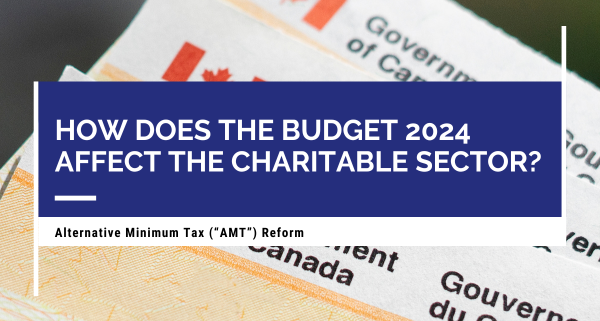How does the Budget 2024 affect the charitable sector?

Originally published by the CAGP on April 30, 2024 – https://www.cagp-acpdp.org/en/blog/how-does-the-2024-budget-effect-the-charitable-sector
On April 16, 2024, the Canadian federal budget was tabled. How does this budget affect the charitable sector?
Alternative Minimum Tax (“AMT”) Reform
In effect for almost forty years, AMT was introduced as a means for the government to ensure individuals and certain trusts pay at least a minimum amount of tax. AMT is an alternative tax regime where high-income earners and trusts calculate their income tax liability based on rules that allow for fewer tax deductions, exemptions, and credits than under the regular tax rules. The higher of the two tax liabilities becomes the amount these taxpayers are required to pay. Additional tax paid as a result of AMT can be carried forward for seven years and used against regular tax to the extent regular tax exceeds AMT in those years.
Last year’s federal budget proposed reforms to the existing AMT tax rules which have been in place since 1986 with nominal changes. This was followed by draft tax legislation being released on August 4, 2023, and then a month-long public consultation period. Unlike the existing AMT tax rules, the proposed amendments to the AMT rules have the potential to negatively impact charitable giving by high-income earners. The 2023 Fall Economic Statement did not table the tax measure changes related to AMT as the government suggested further study was required.
The 2024 federal budget includes further amendments to the AMT tax rules that were originally proposed in the 2023 federal budget and drafted in the August 4, 2023 tax legislation. In particular, this year’s budget proposes that taxpayers can claim 80% of the charitable donation tax credit when calculating AMT, instead of the 50% proposed in the 2023 budget–which is good news. Second, changes to the capital gain inclusion rate on realized capital gains on or after June 25, 2024, may keep more donors in the ‘regular tax system’ rather than pull them into the AMT tax regime.
Unfortunately, the 2024 federal budget does not propose to change the draft legislation which will include 30% of capital gains on the charitable donations of publicly-listed securities for purposes of the AMT calculation. This element of AMT tax reform stays as it was originally proposed in the 2023 federal budget.
Capital Gains Inclusion Rates
The 2024 budget proposes to increase the capital gains inclusion rate from 50% to 66.67% for individuals on capital gains in a year that exceed $250,000 and for corporations and trusts. Individuals will continue to include 50% on the first $250,000 of realized capital gains in the calendar year. These changes apply to capital gains realized after June 24, 2024. The question arises: will the increased inclusion rates affect charitable giving and should gifts be made before or after June 25, 2024?
There are two categories of gifts: those that yield taxable capital gains and those that don’t. Gifts with capital gains that are not taxable are gifts of publicly-listed securities, Canadian cultural property, and ecologically sensitive land. In these cases, the Income Tax Act provides that the capital gains are deemed to be $0 for income tax purposes. We assume that after June 25, 2024, the capital gains on these donated assets will be deducted from the total capital gains before determining the applicable taxable inclusion rates. Since capital gains on these donated assets are reported at nil, the change to the capital gain inclusion rates should not make a difference to the donor where AMT doesn’t apply. In other words, donors do not pay capital gains tax on these charitable gifts whether they donate before June 25 or after June 24. However, donors subject to the 66.67% capital gains inclusion rate will save more tax after June 24, 2024, because the tax rates will have increased.
One aspect of the capital gains changes, which has not yet received much attention, but is important for our work, is the effect on estates. There are very few Canadians who realize annual capital gains over $250,000. But there are many Canadians, who at death may have capital gains over $250,000, because they are required to report the accrued gains on capital property they own at the time of their death. For these Canadians, income tax at death will increase. Donors may want to consider a gift in their will of appreciated publicly-listed securities to charity to reduce their taxable capital gains at death.
The second category of gifts are those that yield capital gains that are taxable. These include gifts of private company shares, real estate and mining flow-through shares. Generally, in these cases, the donor receives a donation tax receipt for the value of the donation and has to report on their tax return, 50% of whatever the accrued capital gain on the donated asset is for a donation made prior to June 25, and 66.67% of the accrued capital gain for a donation in kind after June 24. So, for taxpayers who are subject to the higher inclusion rate (individuals with capital gains over $250,000, and corporations and trusts), the tax savings are less after June 24 because the donor will have a higher income inclusion rate on the capital gain of the gifted property. In these cases, donors may want to make the gift before June 25 to take advantage of the lower capital gains inclusion rate.
Let’s consider a few examples of the impact of these rules on federal taxes.
- Illustration A – Gift of publicly listed securities.
Mr. A has $1,000,000 of employment income and $200,000 of capital gains. He wants to donate $500,000 of publicly-listed securities (“PLS”) with a cost base of $100,000 to charity. This charitable gift of PLS does not trigger additional capital gains to report for tax purposes.
The new capital gains inclusion rules have no impact on Mr. A’s gift because the capital gains on the gifted capital property are considered to be $0, assuming AMT does not apply to Mr. A. Therefore, the timing of this gift does not change Mr. A’s tax liability. Also, note that the gift does not increase Mr. A’s taxable capital gains above the $250,000 threshold for the higher capital gains inclusion rate.
Under AMT rules, 30% of the $400,000 capital gain on the gifted shares, or $120,000, as well as 100% of the $200,000 other capital gain are added to Mr. A’s income. 80% of the normal donation tax credit of $165,000 (33% of $500,000) or $132,000 can be claimed for the AMT calculation. These are federal tax numbers only. There is also provincial or territorial AMT to consider as well. Given the AMT’s exemption on the first $173,205 of adjusted taxable income under the AMT rules, the donor will pay income tax under the regular tax rules and will not pay income tax under the AMT rules. However, since many other factors that could impact his tax return, Mr. A should confirm his AMT calculation with his accountant.
- Illustration B – Gift of private company shares
Now let’s consider that Mr. A donates $500,000 of private company shares with a zero cost base, instead of gifting publicly-listed securities after June 24, 2024, and sells the balance of his private company shares with a zero cost base for $2,500,000.
The capital gain of $500,000 on the gift of these shares is taxable. Given the donor has $2,700,000 of other capital gains, $250,000 of the gain on the gifted securities will have a 50% inclusion rate and the balance of the capital gains of $2,950,000 will have a 66.67% inclusion rate. The increased inclusion rate will result in approximately $162,000 more in income tax than if the gift of the shares and sale of the shares were made before June 25.
Under the AMT regime, all $3,200,000 of the capital gain is included in income. Only 80% of the donation tax credit is available under AMT. In this example, Mr. A would have owed a small amount of AMT if the capital gain inclusion rates had not changed but now is not subject to AMT.
Conclusion
CAGP is pleased that the federal government has acknowledged the value of charitable giving by the public by not substantially cutting the donation tax credit available to donors who are subject to the AMT tax regime, but more can be done. These rules have become overly complicated with donors/taxpayers having to consider two levels of income inclusion for capital gains, the applicability of AMT, and potential tax elections. Calculating the tax impact of and explaining major gifts of capital property have become that much more complicated!
The Canada Gives Team
This content is for information purposes only and is not tax advice. Always consult your team of trusted advisors—including a lawyer and accountant with dedicated tax expertise—for strategic tax planning advice specific to your financial circumstances.



